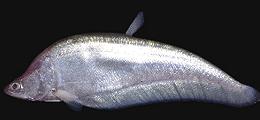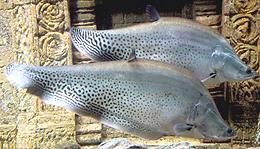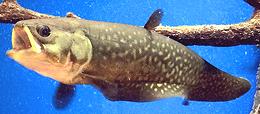 [Family Notopteridae]
[Family Notopteridae]
These fish fall under the informal category of Knifefishes, but most are called Featherbacks for their tiny feather-like dorsal fin. They all live in fresh water or brackish environments in Asia and Africa.
More on Varieties of Fish (very
large page)
 [Clown featherback, Clown knifefish; Pla Grai (Thai); Ca Thac Lac
(Viet); Chitala ornata]
[Clown featherback, Clown knifefish; Pla Grai (Thai); Ca Thac Lac
(Viet); Chitala ornata]
Native to the Mekong Basin, this important food fish is thin, with flesh so
tender it's almost mushy, and so shot full of bones, spines and fin rays it's
difficult to eat whole or as fillets. It is, however, the preferred fish for
fish cakes, fish balls, and some kinds of pickled fish and fish sauce in
Thailand and Vietnam. This fish grows up to 39 inches and 11 pounds but the
photo specimen was 17-1/2 inches long and weighed 1 pound 6-1/8 ounces.
Details and Cooking.
 [Indian Knifefish; Chital (India, Bangladesh); Kandla, Puli (India);
Moi patara, Vuna (Nepal); Gundun (Pakistan); Chitala chitala]
[Indian Knifefish; Chital (India, Bangladesh); Kandla, Puli (India);
Moi patara, Vuna (Nepal); Gundun (Pakistan); Chitala chitala]
This Featherback is native to the Indus, Ganges-Brahmaputra, and Mahanadi
river basins in India, Nepal, and Pakistan. It can grow to 48 inches (122 cm)
but is more comonly 30 inches (75 cm). It is fished commercially in the
region and also farmed. Cooked in a curry, this fish is considered a delicacy
in Assam, West Bengal, and Bangladesh. IUCN Red Listed NT (Near Threatened).
Details and Cooking.
Photo by Hamid Badar Osmany distributed under license
Creative Commons
Attribution-ShareAlike v3.0 Unported.
 [Belida (Maylay, Iban); Chitala hypselonotus]
[Belida (Maylay, Iban); Chitala hypselonotus]
This Featherback is native to Indonesian Sumatra and Borneo. It can grow to
39 inches (100 cm) and 33 pounds (15 kg). It is fished commercially in the
region, IUCN Red Listed LC (Least Concern). For details and cooking,
see Indian Featherback.
Photo by Moushomi B.C. distributed under license
Creative Commons
Attribution-ShareAlike v3.0 Unported.
 [Chitala borneensis]
[Chitala borneensis]
This Featherback is native to Indonesian Sumatra and Borneo, and can grow to
22 inches (56 cm). It is subjet to minor commercial fisheries in the region,
IUCN Red Listed LC (Least Concern). For details and cooking, see
Indian Featherback.
Photo by Nicolas Hubbert, distributed under license
Creative Commons
Attribution-NonCommercial-ShareAlike 3.0 Unported.
 [Mekong Featherback; Royal Knifefish (aquarium trade); Trey krai (Cambodia);
Pa tong kai (Laos); Chitala blanci]
[Mekong Featherback; Royal Knifefish (aquarium trade); Trey krai (Cambodia);
Pa tong kai (Laos); Chitala blanci]
This Featherback inhabits fast flowing waters of the Mekong River, and the
mouths of larger tributaries, prefering rocky bottoms. It can grow to 47
inches long. It is fished commercially and it is now also being farmed.
IUCN Red Listed NT (Near Threatened). For details and cooking, see
Clown Featherback.
Photo by BEDO (Thailand) distributed under license
Creative Commons
Attribution-ShareAlike v4.0 International.
 [Pla salat (Thailand); Cá thát lát (Viet);
Notopterus notopterus]
[Pla salat (Thailand); Cá thát lát (Viet);
Notopterus notopterus]
This Featherback is native to practically all river basins from the Indus
through Southeast Asia, Sumatra, and Java, and occasionally enters brakish
waters. It is absent from Borneo and the Red River of North Vietnam. This
fish is very dark in color when young, and becomes lighter as it matures.
It can grow to 24 inches (60 cm) but is more comonly 10 inches (25 cm) and
is an important food fish throughout its range. It is fished commercially
and also farmed. IUCN Red Listed LC (Least Concern).
Details and Cooking.
Photo by Ajiman distributed under license
Creative Commons
Attribution-ShareAlike v3.0 Unported.
 [Zalazo, Pami Bantara (Nigeria); Fak, Kudamgba, Ndanyei (Sierra Leone);
Dogba, Gouprake, Obroba (Cote d'Ivoire); Papyrocranus afer]
[Zalazo, Pami Bantara (Nigeria); Fak, Kudamgba, Ndanyei (Sierra Leone);
Dogba, Gouprake, Obroba (Cote d'Ivoire); Papyrocranus afer]
This fish is native to the coastal rivers of West Africa, from Senegal through
Nigeria, especially in the Niger Basin, but is absent from the Volta basin.
It can grow to nearly 31 inches. It is able to breath air in oxygen poor
waters, and is able to sense electrical fields, but not create them. This
fish is caught in subsistance fishing, not commercial, and is IUCN rated NT
(Near Threatened).
Photo by Goh Yong Teng distributed under licence Creative Commons
Attribution-ShareAlike v3.0 Unported.